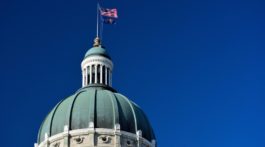by Whitney Downard, Indiana Capital Chronicle
July 15, 2025
A trio of Indiana’s budget leaders emphasized their confidence in the state’s finances at the end of the 2025 fiscal year during a Tuesday press conference — with $2.5 billion in the bank. But three Indianapolis Democrats painted a far darker picture for the average Hoosier.
“Hoosiers can remain confident that our financial footing is stable, despite a year marked by economic fluctuations and a lower-than-expected forecast,” said State Comptroller Elise Nieshalla. “Our reserve continues to serve as a practical safeguard, reflecting Indiana’s commitment to fiscal responsibility.”
Acknowledging slim revenues, Sen. Fady Qaddoura criticized the budget process again on Tuesday, saying that the fiscal closeout doesn’t reflect the actual impact on Hoosiers who rely on food benefits, Medicaid health coverage and state-subsidized child care.
“Technically and mathematically, the 2025 fiscal year ended with a breaking even — almost — scenario,” said the Indianapolis Democrat. “But the story it doesn’t tell is at what expense and who paid for it.”
Nieshalla, Secretary of Management and Budget Lisa Hershman and State Budget Director Chad Ranney were all upbeat as they detailed Indiana’s finances — especially following an April forecast projecting $2 billion less in future revenue over the next two-year budget cycle. Indiana’s fiscal year starts on July 1 and ends on June 30.
“It was a bleak day, if you recall,” summarized Hershman. “We were clinging, I would say, and hoping for a $14 million surplus. I’m proud to say, we far exceeded that.”
The surplus for the 2025 fiscal closeout was $337 million, $170 million more than anticipated just a few months ago. However, nearly all of that additional funding comes from $160 million in advanced tax payments usually paid in December, cutting into revenues for next year.
Ranney noted that the fiscal closeout also included $78 million clawed back from agencies and reverted to the state’s general fund.
That $2.5 billion reserve amount is enough to fund state government for 40 days with no new revenue, within the 30-60 day range considered to be generally advisable.
“… go lower than that (and) I think you start putting yourself in a crunch where you’re worried about cash flow and things like that,” said Ranney.
Reserves will be 11% of Indiana’s spending, at the lower end of the 10-15% recommended to maintain Indiana’s AAA bond rating. Revenues are expected to be relatively stagnant over the next two years, growing by 1.4% next year and 0.1% the following year.
Ranney said he expected those numbers to change following the analysis of a federal bill, but said he didn’t have concerns about Indiana failing to meet its financial obligations.
“The state, at this point, we’re not cutting services. We’re maintaining high levels of services. I think that’s one of the things that Gov. (Mike) Braun insisted on, is that as agencies … reduce spending, they maintain levels of services,” said Ranney. “And we’re doing that.”
Federal actions not calculated into Indiana’s finances
But the behemoth federal reconciliation measure — otherwise known as President Donald Trump’s “Big, Beautiful Bill” — is projected to add $3.25 trillion to the national deficit and cost Indiana hundreds of millions of dollars.
In particular, the already slim forecasted revenue includes more than $300 million each year in provider taxes from hospitals — but is calculated using the current 6% rate, not the new 3.5% cap set to be phased in over the next five years.
Additionally, the state will have to spend more to administer food benefits for Hoosiers. An analysis of the federal law’s impact on Indiana’s finances is underway, Ranney said.
“But, at the moment, we don’t have that information at our fingertips,” he said.
More information is expected to be available in August.
Braun frequently boasts that he voted against almost every bill that added to the deficit during his time on Capitol Hill. He gave his full-throated support for the Trump priority again on Tuesday, saying he was “not at all” concerned about a negative impact to Indiana’s finances.
“Would you like to have a household or be part of a business that’s borrowing 25% of everything you spend each year? No one says yes to that. And that’s our federal government,” said Braun. “So whatever we’ve been getting from them, it’d be like asking your kids at Thanksgiving to lend you money for something you want to do.”
When asked specifically about cuts to Medicaid, food benefits and caps on provider taxes, he said, “we’ll find ways, even if it puts the burden on us to do it better and more efficiently.”
Indianapolis Democrat Rep. Greg Porter said moving the $160 million earlier this year “helped bail us out at this time,” but won’t be available in the future.
“We know we’re going to have cuts,” Porter said, following the passage of the federal measure. “We’re going to have cuts in services.”
Cuts to staff — including 123 layoffs at the Department of Workforce Development and more than 50 other state employees — would decrease services and increase wait times for Hoosiers, Porter said.
“We have the lowest amount in our surplus than we’ve had in the last three budgets, and it’s against a higher expenditure level,” added Rep. Ed DeLaney. “So we’re saving and setting aside less, but spending more. This is not a good strategy.”
Chaos in Washington D.C. — including pending tariffs, a $100 million loss for Hoosier schools and cuts to federal agencies — is creating more economic uncertainty, and Democrats worried that another recession would further hurt public schools, which saw steep cuts during the 2008 recession.
“That money never came back,” said DeLaney, who’s also an Indianapolis Democrat.
Much of the education increase in the latest budget went to subsidizing private school vouchers for the wealthiest Hoosiers — a key criticism for Qaddoura, who also criticized the federal bill’s inclusion of tax cuts for the wealthy while cutting social services.
“Instead of the ‘Big, Beautiful Bill, I call it the billionaire’s bailout bill,” he said. “It, unfortunately, shifts the support and the incentives to corporations and to wealthy families or wealthy individuals and, at the same time, that is really neglecting and leaving behind the most vulnerable in our communities.”










